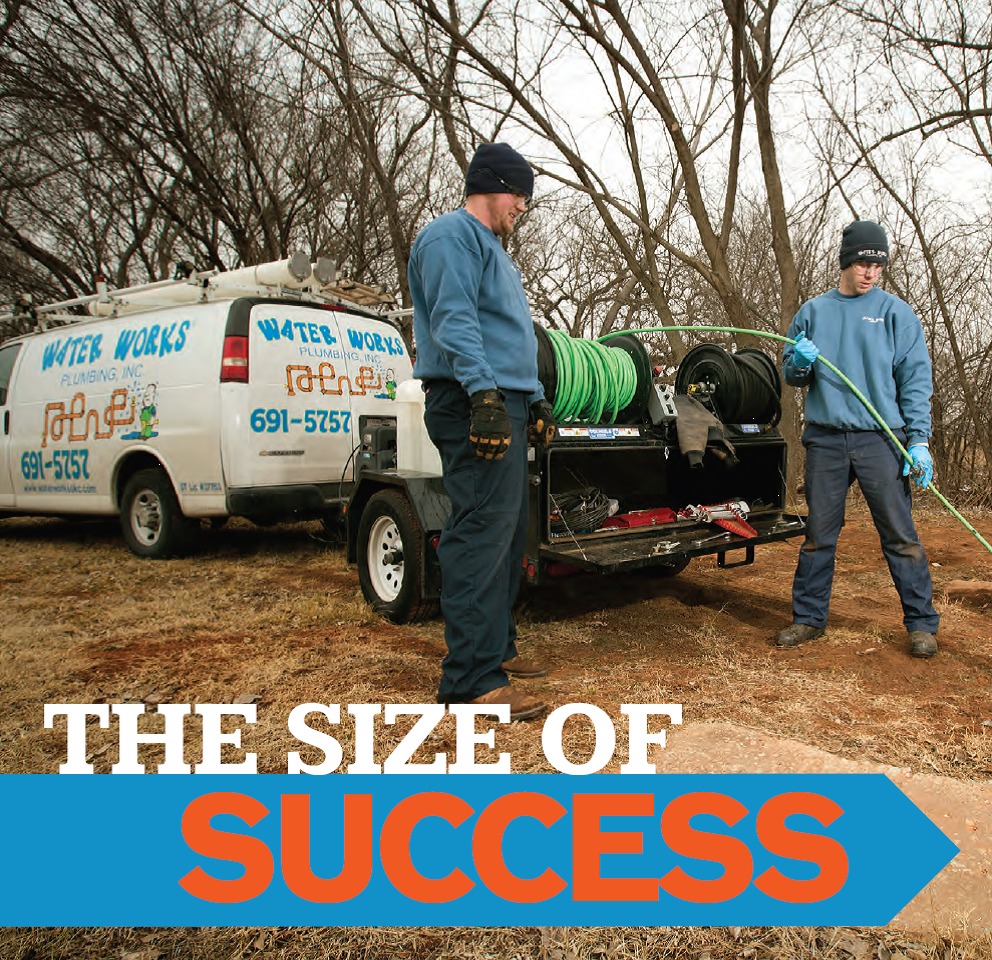Cleaner Magazine- “THE SIZE OF SUCCESS”
Water Works Plumbing focuses on the quality of its work, not putting more trucks on the road. (Using The Eagle 200 Trailer Jetter By Jetters Northwest!)
The Size Of Success
By Luke Laggis
June 2014
Some contractors strive to be the biggest. John Johnson would rather be the best.
Johnson owns and operates Water Works Plumbing in Oklahoma City. He currently has three service trucks and six employees, including three plumbers in the field, his wife, Donna, who handles the bookkeeping and human resources, dispatcher Joanna See and Johnson, who likes to spend as much time in the field as possible. He says it’s tough to operate in the two- to five-truck size range, but it’s the size he prefers.
“I have a very professional mom-and-pop mentality, which is kind of an in-between spot,” Johnson says. “I like the feel of a small company. I like the good relationships you can have with your employees in a small company environment, but I still want to deliver top-notch service, the unusual and tough solutions that no one else can figure out. The only way you can do it is if the few people you do surround yourself with happen to be incredible.
“I like to be involved in what’s going on in the field. Our size is good because I can supervise and oversee the quality of our work and have personal involvement with each of our plumbers.”
Getting started
Johnson comes from a family of tradesman, but he didn’t pursue that path early on. Instead, he worked as an auditor and mortgage accountant, and eventually got laid off in the early 1980s. He then took a job as an apprentice at a plumbing firm in Oklahoma City. After he finished his apprenticeship and got his contractor’s license, he and Donna struck out on their own.
“It was me in a truck and Donna with a pencil and paper and phone,” Johnson recalls. “I’d take a roll of quarters out on the road with me so I could stop at a pay phone and call in, and I had a pager. I just started by word of mouth, making sure everybody I met knew what my business was.”
Water Works started in residential and commercial plumbing repair services such as toilet and faucet repairs, garbage disposals, replacing water heaters, and restaurant service. “I put fliers in everyone’s door in my neighborhood, and all the neighborhoods around me, and I knocked on every restaurant and business door that was within five miles of my house until I was able to drum up enough business. Then that business turned into repeat business and referral business,” Johnson says. “I still have customers today who were my customers within the first month or two of when we started. I’m very grateful for that.”
Johnson eventually got into drain work as he was able to acquire equipment, including cameras, excavation equipment, and eventually, pipe bursting equipment. Oklahoma City is full of deep sewer lines, but there typically isn’t enough room to use a large backhoe. Johnson’s crew frequently digs down as far as possible – about 7 feet – with a Kubota U17, sets up shoring, and then digs the rest out by hand and runs it up in buckets. They also use a spade bit on their Bosch rotary hammer for some excavation work.
“We use that down in the ditch, digging out dirt from around city mains,” Johnson says. “It’s really hardpan clay or sandstone around here and sometimes once you get down in the ditch and you need to do a little hand digging, there’s no hand digging to be done because the soil is so tight.”
Current services
General plumbing services still provide a foundation for Water Works, but drain maintenance and replacement are now an equal or larger part of the business.
“That’s been a good niche for us, especially with pipe bursting because we were one of the first companies in the state to offer it,” Johnson says. “We’ve been successful with that. We’ve done several difficult projects, several projects for other plumbing contractors as well.”
He says it’s about providing what people need, not just what they want. He’s filling a niche and solving problems that people need to have fixed.
“I want to be able to do things that ensure people will call us for something,” Johnson says. “So they may need a major pipe bursting job with 600 feet of 6-inch pipe that has to be run under a mobile home park. We can do that, and we have done that. They may need a toilet flapper replaced because their toilet runs at night and wakes them up, and we can do that. And if we find something else weird that’s bugging our customers, I’m probably going to learn how to do that, too. I don’t want to stop learning how to do new things, because that’s how I keep myself and my guys employed.”
Pipe bursting is one of the company’s specialties, but Johnson says it’s not so special to him and his crew anymore because they’ve done so much of it over the past nine years. It’s just like another pipe wrench in the tool bag, he says.
“For us, if a pipe bursting job is what needs to be done today, fine, we’re prepared. We’ve got the equipment and we can get it done in a big way, but if what you need is a spot repair, we can dig that up and do a spot repair,” Johnson says.
On one job they burst over 4,000 feet of pipe, and Johnson says that didn’t even scratch the surface of all the pipe on the property.
“They have other clay pipes, and any plumber could make a pretty good case for the fact that they should all be replaced, but we’ve been able to use RootX and our hydrojetting equipment from Jetters Northwest to keep those lines in service without having to replace everything.”
Johnson and his wife also own and operate a Bath Fitter franchise from their location. The franchise focuses solely on tub and shower renovations. This division of his operation is just another niche service that helps keep everyone on the job. The bath remodel business has its own installers, estimators and administrative staff.
High-pressure solution
Johnson is always looking for new opportunities to serve his customers’ needs. It wasn’t until late 2012 that he finally got into jetting.
“The jetter we use from JETTERS NORTHWEST has opened the doors to a lot of things we couldn’t do before,” he says.
The company uses the Eagle 200 trailer jetter primarily on root blockages and also relies on it for other tough clogs. It features a 28 hp Subaru engine and 300 feet of hose along with 300 additional feet on a separate reel. He went with the trailer jetter over a similar cart jetter to eliminate water supply issues. Warthog (StoneAge) and RootRat (Chempure Products) jetter nozzles are typically affixed to the business end of the jetter.
“Here I am, 22 years in business and I’m taking on new things, trying to learn new processes, because plumbing service is becoming more and more competitive. I don’t want to be in a position where one piece of equipment can cost me a key customer.”
Curing the ills
“The three biggest sewer problems for us are from three different eras,” Johnson says. “We have clay pipes from about the turn of the 20th century forward through the ’40s. In the ’40s up through the early ’60s we had concrete pipe. From the ’60s we had Orangeburg pipe, and then from the early ’70s forward PVC started to come in.”
Johnson says each product has its own weaknesses, things you can and can’t do with it.
“Fortunately in Oklahoma City, if you’ve worked around here long enough you can look at a map and tell what kind of sewer line they have before you ever go out there, just because you know the age of that neighborhood.
“I like clay, because if it’s still together, even if it has bad root intrusion, if it’s not broken down you can be pretty aggressive and get the roots out,” he adds. “Roots are the big thing in the sewers around here.”
Johnson says he’s also seeing more issues from low-flow toilets, and he expects that to increase in the coming years. Water Works tackled a huge project for a bank and another in an old church, both of which had problems related to low-flow toilets installed on 4-inch cast-iron pipe.
“There’s just not enough water to get everything to flow down,” he says. “They’re lucky sometimes if the waste and the paper can go 20 feet downstream, much less make it all the way to the city main.”
Water Works also does a fair share of inspection work with RIDGID SeeSnake cameras and NaviTrack locators. Like the pipe bursting equipment, these tools have helped keep the company busy. Johnson says everything works together.
“Jetting blind upstream is something you’d never want to do without the camera equipment, and being sure all the debris gets flushed downstream … you can’t do that without a jetter. They really go hand in hand.”
Careful consideration
Johnson spends a lot of time shopping when he’s in the market for new equipment, and he’s constantly on a quest for information. He’ll also ask other contractors how they’re using a piece of equipment and what they like and don’t like about it. He says he spent several months researching before he bought the JETTERS NORTHWEST unit.
Cured-in-place lining is one area the company has not ventured into yet. Johnson says he hasn’t come across enough need and opportunity to justify the expense. Besides, he is a big believer in the end product with pipe bursting. He’s so confident in his HDPE installations that he gives customers a written 50-year warranty.
“It’s not a big deal to me. The pipe has a 100-year life expectancy, it’s practically impervious to everything except open excavation and dynamite. You can’t tear it apart, it’s fused together, and it’s scientifically impossible for roots to grow through a fused joint, so yeah, I give a 50-year warranty. It’s not going to break. It’s not like I’m risking much.”
Johnson says with short manufacturer warranties on pipe patching and lining systems, the high initial cost of equipment, the learning curve and risk factor if there are problems, it’s just not for him. Still, it’s not out of the question. He says he’s intrigued by pipe patching systems for repairs in inaccessible locations, and he’ll likely buy into that before a full lining system.
“Five years ago that’s how I felt about jetting. Heck, 15 years ago that’s how I felt about email. So nothing is ever written in stone. By the time this hits the press, I may be shopping for a lining system.”



